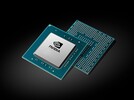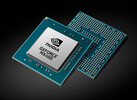NVIDIA Quadro T1000 (Laptop) vs NVIDIA Quadro RTX 4000 Max-Q vs NVIDIA T500 Laptop GPU
NVIDIA Quadro T1000 (Laptop)
► remove from comparison
The Nvidia Quadro T1000 for laptops is a professional mobile graphics card that is based on the Turing architecture (TU117 chip). Compared to the consumer GTX 1650, the Quadro T1000 features less CUDA cores / shaders (768 versus 896). The Quadro T2000 uses the same TU117 chip, but features all 1024 cores (2x to the T1000) and is therefore significantly faster. The chip is manufactured in 12nm FinFET at TSMC.
The Turing generation did not only introduce raytracing for the RTX cards, but also optimized the architecture of the cores and caches. According to Nvidia the CUDA cores offer now a concurrent execution of floating point and integer operations for increased performance in compute-heavy workloads of modern games. Furthermore, the caches were reworked (new unified memory architecture with twice the cache compared to Pascal). This leads to up to 50% more instructions per clock and a 40% more power efficient usage compared to Pascal. In contrary to the faster Quadro RTX cards, the T1000 and T2000 don not feature raytracing and Tensor cores.
NVIDIA Quadro RTX 4000 Max-Q
► remove from comparisonThe Nvidia Quadro RTX 4000 with Max-Q Design is a professional high-end graphics card for powerful laptops and mobile workstations. The Max-Q variants are lower clocked versions that are running more efficient and can be used in smaller chassis than the regular versions. It is based on the same TU104 chip as the consumer GeForce RTX 2080 (mobile) but offers fewer shaders (2,560) and is therefore positioned between the GeForce RTX 2080 (2,944) and 2070 (2,304). Currently we know of three different Max-Q variants with a power consumption (TGP) of 90, 85 and 80 Watt and different clock speeds.
| Model | Shader | TGP (W) | Base (MHz) | Boost (MHz) |
| Quadro RTX 4000 Desktop | 2304 | 160 | 1005 | 1545 |
| Quadro RTX 4000 Mobile | 2560 | 110 | 1350 | 1770 |
| Quadro RTX 4000 Max-Q | 2560 | 90 | 960 | 1485 |
| Quadro RTX 4000 Max-Q | 2560 | 85 | 900 | 1440 |
| Quadro RTX 4000 Max-Q | 2560 | 80 | 780 | 1380 |
| GeForce RTX 2070 Mobile | 2304 | 115? | 1215 | 1440 |
The Quadro GPUs offer certified drivers, which are optimized for stability and performance in professional applications (CAD, DCC, medical, prospection, and visualizing applications). The performance in these areas is therefore much better compared to corresponding consumer GPUs.
Features
NVIDIA manufacturers the TU104 chip on a 12 nm FinFET process and includes features like Deep Learning Super Sampling (DLSS) and Real-Time Ray Tracing (RTRT), which should combine to create more realistic lighting effects than older GPUs based on the company's Pascal architecture (if the games support it). The Quadro RTX 5000 is also DisplayPort 1.4 ready, while there is also support for HDMI 2.0b, HDR, Simultaneous Multi-Projection (SMP) and H.265 video en/decoding (PlayReady 3.0).
Performance
For professional applications, the Quadro RTX 4000 Max-Q should be only slightly above the mobile Quadro RTX 3000 (depending on the version). Compared to consumer cards, the mobile RTX 2070 will offer a similar performance (or slightly lower).
The still relatively high power consumption of the RTX4000 Max-Q makes the card most suited for big laptops although we should see thinner designs with the Max-Q variants.
NVIDIA T500 Laptop GPU
► remove from comparison
The Nvidia T500 Mobile (formerly known as Quadro T500) for laptops is a professional mobile graphics card that is based on the Turing architecture (TU117 chip). It is based on the consumer GeForce MX450 and features the same 896 cores and a 64 Bit memory bus. Currently it is available with 2 or 4 GB graphics RAM (GDDR5 or GDDR6). The TDP ranges between 18 - 25 Watt depending on the variant. As the MX450, the T500 also supports PCIe 4.0. The chip is manufactured in 12nm FinFET at TSMC.
The Turing generation did not only introduce raytracing for the RTX cards, but also optimized the architecture of the cores and caches. According to Nvidia the CUDA cores offer now a concurrent execution of floating point and integer operations for increased performance in compute-heavy workloads of modern games. Furthermore, the caches were reworked (new unified memory architecture with twice the cache compared to Pascal). This leads to up to 50% more instructions per clock and a 40% more power efficient usage compared to Pascal. In contrary to the faster Quadro RTX cards, the T500 does not feature raytracing and Tensor cores.
| NVIDIA Quadro T1000 (Laptop) | NVIDIA Quadro RTX 4000 Max-Q | NVIDIA T500 Laptop GPU | ||||||||||||||||||||||||||||||||||||||||||||||||||||||||||||||||||||||||||||||||||||||||||||||||||||||||||||||||||||||||||||||||||||||||||||||||||||||||||
| Quadro Turing Series |
|
|
| |||||||||||||||||||||||||||||||||||||||||||||||||||||||||||||||||||||||||||||||||||||||||||||||||||||||||||||||||||||||||||||||||||||||||||||||||||||||||
| Codename | N19P-Q1 | N19E-Q3 MAX-Q | ||||||||||||||||||||||||||||||||||||||||||||||||||||||||||||||||||||||||||||||||||||||||||||||||||||||||||||||||||||||||||||||||||||||||||||||||||||||||||
| Architecture | Turing | Turing | Turing | |||||||||||||||||||||||||||||||||||||||||||||||||||||||||||||||||||||||||||||||||||||||||||||||||||||||||||||||||||||||||||||||||||||||||||||||||||||||||
| Pipelines | 768 - unified | 2560 - unified | 896 - unified | |||||||||||||||||||||||||||||||||||||||||||||||||||||||||||||||||||||||||||||||||||||||||||||||||||||||||||||||||||||||||||||||||||||||||||||||||||||||||
| Core Speed | 1395 - 1455 (Boost) MHz | 780 - 960 - 1380 - 1485 (Boost) MHz | 1365 - 1695 (Boost) MHz | |||||||||||||||||||||||||||||||||||||||||||||||||||||||||||||||||||||||||||||||||||||||||||||||||||||||||||||||||||||||||||||||||||||||||||||||||||||||||
| Memory Speed | 8000 MHz | 14000 MHz | 10000 MHz | |||||||||||||||||||||||||||||||||||||||||||||||||||||||||||||||||||||||||||||||||||||||||||||||||||||||||||||||||||||||||||||||||||||||||||||||||||||||||
| Memory Bus Width | 128 Bit | 256 Bit | 64 Bit | |||||||||||||||||||||||||||||||||||||||||||||||||||||||||||||||||||||||||||||||||||||||||||||||||||||||||||||||||||||||||||||||||||||||||||||||||||||||||
| Memory Type | GDDR5 | GDDR6 | GDDR5, GDDR6 | |||||||||||||||||||||||||||||||||||||||||||||||||||||||||||||||||||||||||||||||||||||||||||||||||||||||||||||||||||||||||||||||||||||||||||||||||||||||||
| Max. Amount of Memory | 4 GB | 8 GB | 4 GB | |||||||||||||||||||||||||||||||||||||||||||||||||||||||||||||||||||||||||||||||||||||||||||||||||||||||||||||||||||||||||||||||||||||||||||||||||||||||||
| Shared Memory | no | no | no | |||||||||||||||||||||||||||||||||||||||||||||||||||||||||||||||||||||||||||||||||||||||||||||||||||||||||||||||||||||||||||||||||||||||||||||||||||||||||
| API | DirectX 12_1, OpenGL 4.6 | DirectX 12_1, OpenGL 4.6 | DirectX 12_1, OpenGL 4.6 | |||||||||||||||||||||||||||||||||||||||||||||||||||||||||||||||||||||||||||||||||||||||||||||||||||||||||||||||||||||||||||||||||||||||||||||||||||||||||
| Power Consumption | 50 Watt | 80 - 90 Watt | 25 Watt | |||||||||||||||||||||||||||||||||||||||||||||||||||||||||||||||||||||||||||||||||||||||||||||||||||||||||||||||||||||||||||||||||||||||||||||||||||||||||
| technology | 12 nm | 12 nm | 12 nm | |||||||||||||||||||||||||||||||||||||||||||||||||||||||||||||||||||||||||||||||||||||||||||||||||||||||||||||||||||||||||||||||||||||||||||||||||||||||||
| Notebook Size | medium sized | large | medium sized | |||||||||||||||||||||||||||||||||||||||||||||||||||||||||||||||||||||||||||||||||||||||||||||||||||||||||||||||||||||||||||||||||||||||||||||||||||||||||
| Date of Announcement | 27.05.2019 | 27.05.2019 | 27.05.2019 | |||||||||||||||||||||||||||||||||||||||||||||||||||||||||||||||||||||||||||||||||||||||||||||||||||||||||||||||||||||||||||||||||||||||||||||||||||||||||
| Transistors | 10.8 Billion | |||||||||||||||||||||||||||||||||||||||||||||||||||||||||||||||||||||||||||||||||||||||||||||||||||||||||||||||||||||||||||||||||||||||||||||||||||||||||||
| Features | DLSS, Raytraycing, VR Ready, G-SYNC, Vulkan, Multi Monitor |
Benchmarks
3DM Vant. Perf. total + NVIDIA Quadro T1000 (Laptop)
specvp12 sw-03 + NVIDIA Quadro T1000 (Laptop)
Cinebench R15 OpenGL 64 Bit + NVIDIA Quadro T1000 (Laptop)
GFXBench T-Rex HD Offscreen C24Z16 + NVIDIA Quadro T1000 (Laptop)
Average Benchmarks NVIDIA Quadro T1000 (Laptop) → 100% n=28
Average Benchmarks NVIDIA Quadro RTX 4000 Max-Q → 159% n=28
Average Benchmarks NVIDIA T500 Laptop GPU → 59% n=28
* Smaller numbers mean a higher performance
1 This benchmark is not used for the average calculation
Game Benchmarks
The following benchmarks stem from our benchmarks of review laptops. The performance depends on the used graphics memory, clock rate, processor, system settings, drivers, and operating systems. So the results don't have to be representative for all laptops with this GPU. For detailed information on the benchmark results, click on the fps number.

Cyberpunk 2077 1.0
2020
Star Wars Squadrons
2020
F1 2020
2020
Gears Tactics
2020
Doom Eternal
2020
Hunt Showdown
2020
Escape from Tarkov
2020
Need for Speed Heat
2019
GRID 2019
2019
FIFA 20
2019
Borderlands 3
2019
Control
2019
F1 2019
2019
Rage 2
2019
Anno 1800
2019
The Division 2
2019
Dirt Rally 2.0
2019
Far Cry New Dawn
2019
Metro Exodus
2019
Apex Legends
2019
Battlefield V
2018
Farming Simulator 19
2018
FIFA 19
2018
Far Cry 5
2018
X-Plane 11.11
2018
Rocket League
2017
For Honor
2017
Rainbow Six Siege
2015
Dota 2 Reborn
2015
The Witcher 3
2015
GTA V
2015
BioShock Infinite
2013Average Gaming NVIDIA Quadro T1000 (Laptop) → 100%
Average Gaming 30-70 fps → 100%
Average Gaming NVIDIA Quadro RTX 4000 Max-Q → 136%
Average Gaming 30-70 fps → 154%
Average Gaming NVIDIA T500 Laptop GPU → 63%
Average Gaming 30-70 fps → 62%
| NVIDIA Quadro T1000 (Laptop) | NVIDIA Quadro RTX 4000 Max-Q | NVIDIA T500 Laptop GPU | |||||||||||||||||||
|---|---|---|---|---|---|---|---|---|---|---|---|---|---|---|---|---|---|---|---|---|---|
| low | med. | high | ultra | QHD | 4K | low | med. | high | ultra | QHD | 4K | low | med. | high | ultra | QHD | 4K | ||||
| Cyberpunk 2077 1.0 | 31 | 17 | 13 | 10.1 | |||||||||||||||||
| Immortals Fenyx Rising | 65 | 35 | 29 | 24 | |||||||||||||||||
| Star Wars Squadrons | 54.7 | 47.2 | 42.4 | ||||||||||||||||||
| F1 2020 | 100 | 59.8 | 44 | 29.3 | |||||||||||||||||
| Strange Brigade | 111 | 34 | 29 | 25 | 17.9 | 9.6 | |||||||||||||||
| Far Cry 5 | 107 | 62 | 57 | 53 | 52 | 30 | 28 | 27 | |||||||||||||
| X-Plane 11.11 | 93 | 80 | 69 | 93.3 | 78.8 | 66.2 | 45.3 | 70 | 63 | 55 | 29.4 | ||||||||||
| Final Fantasy XV Benchmark | 67 | 46 | 33 | 118 | 86.5 | 68.3 | 46.3 | 29.7 | 50 | 24 | 17 | 12.4 | 5.73 | ||||||||
| Dota 2 Reborn | 142 | 125 | 117 | 109 | 47.9 | 131 | 116 | 107 | 101 | 65 | 128 | 118 | 90 | 79 | 27.7 | ||||||
| The Witcher 3 | 179 | 108 | 59 | 35 | 221 | 178 | 115 | 62.6 | 36 | 96 | 52 | 29 | 20 | ||||||||
| GTA V | 170.1 | 153.9 | 93.8 | 41.7 | 141 | 97 | 42 | 21 | 13.2 | 14 | |||||||||||
| NVIDIA Quadro T1000 (Laptop) | NVIDIA Quadro RTX 4000 Max-Q | NVIDIA T500 Laptop GPU | |||||||||||||||||||
| low | med. | high | ultra | QHD | 4K | low | med. | high | ultra | QHD | 4K | low | med. | high | ultra | QHD | 4K | < 30 fps < 60 fps < 120 fps ≥ 120 fps | 3 3 | 1 3 2 | 3 3 | 3 1 | | 1 | < 30 fps < 60 fps < 120 fps ≥ 120 fps | 2 2 | 3 1 | 4 | 2 | 1 | 1 2 1 | < 30 fps < 60 fps < 120 fps ≥ 120 fps | 3 5 2 | 2 6 3 | 6 4 1 | 7 1 1 | 3 | 5 |
For more games that might be playable and a list of all games and graphics cards visit our Gaming List

























